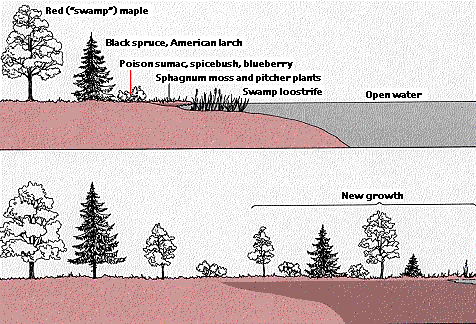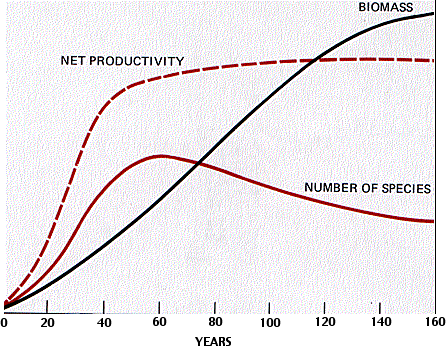Plant Succession
Many plant communities are not self-sustaining. A field in the temperate deciduous forest biome will remain a field only as long as it is grazed by animals or mowed regularly. If these factors are eliminated, the balance tips in favor of other species. The newcomers many, in turn, by their own growth sow the seeds of their own destruction. For example, the gray birch grows well only in sunny locations. The shade it casts prevents its own seedlings from growing beneath it, but permits white pine seedlings to become established. When mature, white pines then cast so deep a shade that the gray birch is no longer able to survive there.
Primary Plant Succession
The process of plant succession begins just as soon as a land area capable of supporting plant life is formed. Some examples:
- accumulation of sand dunes at the edge of the ocean or a lake
- exposure of rock by a retreating glacier
- cooling of a lava flow
Bare rock succession in the temperate deciduous forest biome
- The first colonizers are lichens and certain mosses. Acids secreted by the lichens attack the rock and provide bits of soil. Additional soil particles may be formed by weathering or be blown in from elsewhere. Damage and decay to the lichens supplies some humus, and eventually enough soil is formed to support other mosses
- The growth, death, and decay of mosses produces more humus, and soon there is enough to support the growth of
- grasses and
- shrubby growth such as blueberries. These, in turn, provide the conditions for such sun-loving, fast-growing species as
- gray birch trees and poplars (quaking aspens).
- In time, white pines replace these. In the dense shade of mature white pines, only shade-tolerant maples and beech seedlings thrive.
When these large trees finally take over, the succession comes to an end. Maple and beech seedlings are able to develop under the conditions imposed by their parents, and the population becomes self-sustaining. It is known as a climax forest.
Bog succession

Another example of plant succession occurs as shallow ponds gradually fill in with soil washed in from the surrounding terrain and organic matter produced by underwater plants.
As we walk from the edge of a poorly-drained, boggy pond back into the forest, we pass through a series of zones that recreate in space the plant succession that has been occurring in time.
- From the swamp loosestrife and other plants at the waters edge past
- sphagnum moss and pitcher plants, then
- blueberries and poison sumac, followed by
- black spruce and American larch and, finally,
- swamp maples and white pines
one passes concentric zones, each representing a later stage of plant succession as the soil has become firmer and dryer and the shade denser.
Secondary Plant Succession
Lumbering, grazing, farming, fires, and hurricanes interrupt the process of succession by removing the dominant plants in the community. Their elimination sets the stage for a new succession to begin.
The many abandoned farms in New England (I live on one) illustrate this. People often wonder why our pioneers built stone walls through the woods. The answer is that they did not. The walls in the woods today once marked the boundaries of fields and pastures, but when cultivation and grazing ceased, a secondary succession began.
- The grass of abandoned fields soon gave way to weeds and low shrubby growth.
- Soon gray birch, poplars, and/or cedars flourished.
- White pines or, in sandy well-drained locations, oaks followed.
- If they are left alone, we will someday see again a climax forest of maples and beeches.
The colonization of bare rock, the filling in of a pond, and the secondary succession that follows the abandonment of a field each involve different species in the early stages. In any given region, though, the species in the final, self-sustaining climax forest are the same. The tendency for all plant communities to end in the same climax community is called convergence.
 In general, plant succession is a reflection of the increasing efficiency of the community at intercepting the energy of the sun and converting it into chemical energy. As one stage of succession follows another,
In general, plant succession is a reflection of the increasing efficiency of the community at intercepting the energy of the sun and converting it into chemical energy. As one stage of succession follows another,
- the biomass of the community increases. This is the outcome of the increasing amount of
- net productivity — calories stored by the plant community.
- This, in turn, provides calories for a larger community of consumers.
- As succession continues, the diversity of species in the community increases — at least for a time.
- When the system approaches its climax, the rate of increase in net productivity of the plants is consumed by its own heterotrophs.
- The system comes into equilibrium and reaches peak efficiency at channeling the energy of the sun into the food web of the community.
The graph (from Whittaker, R. H., Communities and Ecosystems, Macmillan, 1970) shows the changes in number of species, biomass, and net productivity during secondary succession in a temperate deciduous forest over a period of 160 years.
More recent work has extended such analysis to periods of thousands of years. This is possible by exploiting the phenomenon discussed above in bogs — the fact that zones of succession recreate in space the changes that have taken place over thousands of years of time.
Studying succession in six different biomes, including tropical rain forest, temperate rain forests as well as taiga, it was found that — if nothing (hurricanes, fire) has disturbed the climax forest — eventually the soil becomes less fertile and the biomass of the forest declines.
You can read about this work in Wardle, D. A., et al., Science, 23 July 2004.
8 Aug 2004

 In general, plant succession is a reflection of the increasing efficiency of the community at intercepting the energy of the sun and converting it into chemical energy. As one stage of succession follows another,
In general, plant succession is a reflection of the increasing efficiency of the community at intercepting the energy of the sun and converting it into chemical energy. As one stage of succession follows another,